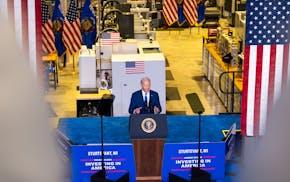MOSCOW – Russian policymakers are signaling they're prepared to sacrifice economic growth in order to stabilize the ruble.
The Bank of Russia raised its benchmark interest rate by the most in 16 years last week and created a money-market cash squeeze, helping the ruble strengthen 45 percent from a record low on Dec. 16. The consequence of this means the oil producer's economy may shrink 7.9 percent in 2015, Danske Bank said on Dec. 19, revising a view for a 1.8 percent contraction.
"We're seeing a serious monetary shock, especially next year," Vladimir Miklashevsky, a strategist at Danske, said by phone the same day. "What they've done is more serious for the economy than falling oil, it's a big negative factor."
While the ruble's plunge may have halted for now, challenges are deepening for the economy, which has been weakened by U.S. and European sanctions over Ukraine. President Vladimir Putin told Russians last week to brace for a recession as this year's 45 percent drop in oil undermines the world's biggest energy exporter. If crude drops further, the ruble's hard-won stability may prove short-lived, said Vladimir Vedeneev at Raiffeisen Capital in Moscow.
The ruble gained 6.3 percent to 55.08 per dollar at 6:24 p.m. Monday in Moscow, after China offered Russia help with the suggestion of wider currency swaps. It advanced 5 percent on Dec. 19, strengthening from a low of 80.1 on Dec. 16. One-day interbank deposit rates dropped to 20 percent from 22.5 percent on Dec. 19. The Bank of Russia raised its rate 6.5 percentage points to 17 percent on Dec. 16.
Higher interest rates and a weaker ruble are combining to squeeze Russian companies and individual as growth stalls. The economy may shrink 4.5 percent in 2015 if oil stays at $60 per barrel, the central bank said on Dec. 15.
The ruble lost as much as a fifth of its value on Dec. 16, blowing through that day's surprise rate increase and sparking concern that Russia would announce capital controls. It was only when the higher rates led to a shortage of rubles that the currency began its rebound. The currency is still down 45 percent this year.
"The peak of the currency crisis is behind us as authorities have taken decisive and appropriate actions," Bernd Berg, a London-based emerging-market strategist at Societe Generale, said in an e-mail Friday. "There is still work to be done and the ruble might remain very volatile in the short term. Over time, volatility will calm down and the ruble steadily appreciate assuming stabilizing oil prices."
The ruble's drop this year has been aggravated by traders betting on central bank intervention to slow its decline. The cash squeeze created last week "stopped local banks from shorting the ruble" using funds previously obtained from central bank liquidity injections, Danske's Miklashevsky said.
The success of Russia's support for the ruble depends on oil prices and the longevity of sanctions, according to Oleg Kouzmin, an economist at Renaissance Capital in Moscow.
"At the current oil price of $60 a barrel," if sanctions aren't tightened, the ruble might average around 50 in the midterm, Kouzmin said by e-mail Friday. If there's a "massive run on the currency among the population," the ruble might "move to levels that are difficult to quantify," he said.
This year's oil slump accelerated after the Organization of Petroleum Exporting Countries held its output target. Russia gets about half of its budget revenue from oil and gas.
Policymakers made it "more expensive to play against the ruble," Aleksei Belkin, who helps manage about $4 billion at Kapital Asset Management, said by e-mail from Moscow on Friday. "It's a bit too soon to judge the effectiveness as it is natural for buyers and sellers to back off on the days following such massive moves."
Union push pits the United Farm Workers against a major California agricultural business
Tiger Woods to be lone player on negotiating committee with Saudis

